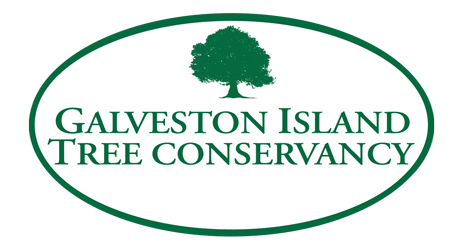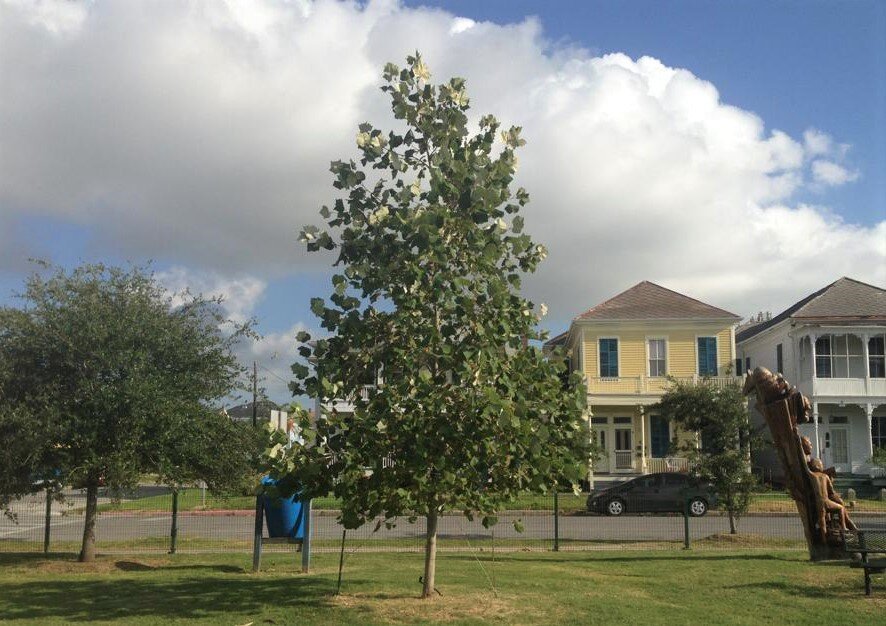Plant a Sycamore
Want Shade? Plant a Sycamore
Certainly everyone has enjoyed our brief respite from the “dog days” As August again heats up, our minds and bodies (and dogs) seek shady places: places that cool our bodies, homes, offices, streets and sidewalks. Hurricane Ike took many of those along with our trees, so we’ve been planting as quickly as possible to replenish our shade. For their part, the trees have been growing as quickly as they can!
So it seems obvious to ask which trees give us the best bang for our buck, quick-shade wise? A sure winner is the stalwart sycamore. We have two varieties in Galveston: the traditional American sycamore (Platanus occidentalis) and the more recently introduced Mexican sycamore (Platanus mexicana). Both grow quickly and produce large maple-like leaves which provide abundant summer shade, but drop in winter to let the sunshine in. They have moderate water needs and drought tolerance.
Of course the big leaves are the reason some folks avoid sycamores. When they drop they can create a large amount of leaf litter. Those big leaves cool us nicely in hot sunny weather, so surely they are worth a bit of raking time. Raking big but fewer leaves is as easy as corralling a zillion little ones. In fall they produce seed balls that resemble tiny UFOs.
Sycamores have attractive smooth bark which flakes off in irregular masses. The tough texture of the bark tissue lacks the elasticity of some other trees, and cannot stretch to accommodate the growth of the wood underneath. It falls away to reveal an attractive mottled surface. The wood is used for butcher's blocks, furniture, crates, and even musical instruments. Seeds are enjoyed by a variety of birds.
Also known as American Planetree or buttonwood, the occidentalis is native to North America. The mexicana originated in Central America and Mexico. Some genetic researchers believe that the mexicana is the closest descendant to ancestral sycamore precursors and that all Platanus trees have some Mexican sycamore in them.
These beauties can grow fast, producing abundant shade long before other species. They must definitely be planted in the right place where they will have room to grow up and out--not under a power line! In good conditions they can reach 70-100 feet, although less on the Island.
Unfortunate for many of the Island’s older sycamores has been the mutilation done in the name of pruning. The discouraged custom of “topping” them and lopping off huge limbs has left many unattractive and unhealthy. When left to grow naturally they are graceful and shapely trees.
Sycamores, both American and Mexican, have been choices available for Galveston Tree Conservancy’s NeighborWoods plantings for right-of-way areas which can accommodate large trees. As a result we have a ready-made laboratory to evaluate their performance. The Mexican Sycamore at 16th and Sealy was a 2010 NeighborWoods selection and in only four years has grown from eight to over 25 feet in height. So plant one of your own and sit back and watch it grow! You will be impressed.
Hurricane Ike caused the loss of 40,000 trees on Galveston Island. The Galveston Island Tree Conservancy was formed to address that loss and to date has replaced almost 14,000 through grant-funded plantings and giveaways, with more planned. “Tree Stories” is an ongoing series of articles intended to bring attention to outstanding Island trees, tree care, and tree issues. If you have or know of a special tree on Galveston Island that should be highlighted, please email treesforgalveston@gmail.com. Margaret Canavan is a Galveston resident, a Galveston County Master Gardener, and a member of the Conservancy Board.

